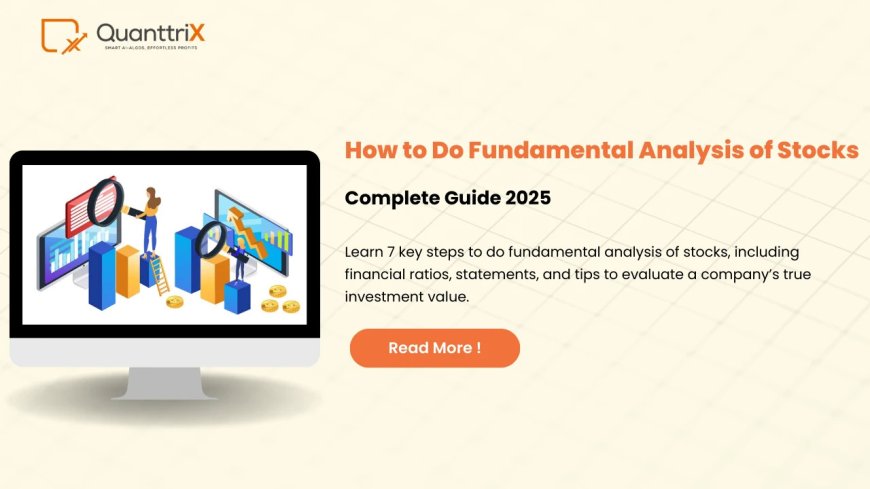How to Do Fundamental Analysis of a Stock – Simple Guide
Learn how to do fundamental analysis of a stock. Understand metrics, strategies & impact on algo trading software price, algorithmic trading software price, automated trading software.

How to Do Fundamental Analysis of a Stock (Beginner-Friendly Guide)
Introduction
Have you ever wondered how successful investors like Warren Buffett choose their stocks? They don't rely on gut feelings. They study. They analyze. They look under the hood of a company, just like a mechanic checks a car engine before a long road trip. That, in simple terms, is fundamental analysis.
If youre interested in the stock market, or even considering tools like algo trading software, understanding the fundamental analysis is your first big step. Whether you're a curious beginner or someone ready to take control of your investments, this guide will help you understand the what, why, and how of evaluating a companys true worth.
And don't worry, well keep it simpleno complex formulas, no intimidating jargon.
Learn how to do fundamental analysis of a stock. Understand metrics, strategies & impact on algo trading software price, algorithmic trading software price, automated trading software.
What is Fundamental Analysis?
Fundamental analysis is like being a detective. Instead of looking at charts and patterns (thats technical analysis), you dig into a companys health, performance, and future potential. You analyze the financial statements, industry trends, management quality, and more to see whether the stock is undervalued or overvalued.
Why is Fundamental Analysis Important?
Think of buying stocks like buying a house. Would you purchase a home without checking its structure, location, or price compared to nearby properties? Probably not. Similarly, fundamental analysis helps you invest wisely, not emotionally.
-
Reduces risk
-
Supports long-term strategy
-
Helps in identifying value stocks
Types of Fundamental Analysis
There are two broad approaches:
-
Top-down approach: Start with the economy, then industry, then the company.
-
Bottom-up approach: Start with the company, regardless of macro conditions.
Both have their pros. But for beginners, the bottom-up is usually easier to understand.
Step-by-Step Guide to Conducting Fundamental Analysis
Lets simplify the process into clear steps:
-
Understand the business model What does the company do?
-
Read financial reports Balance sheet, income statement, cash flow.
-
Look at ratios How efficient is the company?
-
Check growth trends Is revenue increasing year after year?
-
Assess debt levels Is it manageable?
-
Evaluate the competition Is the company a leader or follower?
Understanding Financial Statements
Imagine a companys financials like your monthly budget:
-
Income Statement = Your salary and expenses
-
Balance Sheet = Your total assets vs debts
-
Cash Flow Statement = Money coming in and going out
Understanding these helps you know if the company is earning money and managing it well.
Key Ratios Every Investor Must Know
Ratios are like quick health indicators. Here are the main ones:
-
Earnings Per Share (EPS) How much profit per share?
-
Price-to-Earnings Ratio (P/E) Is the stock cheap or expensive?
-
Debt-to-Equity Ratio Is the company overburdened with debt?
-
Return on Equity (ROE) How good is management at generating profit?
These numbers give a snapshot of performance and value.
Qualitative vs Quantitative Analysis
Quantitative is numbers and datathings you can measure.
Qualitative is about brand strength, leadership, and innovationthings harder to quantify.
Example: Tesla's numbers (quantitative) vs Elon Musks vision (qualitative).
Smart investors use both.
Industry & Economic Analysis
No business operates in a vacuum. A great company in a declining industry may still underperform.
Look at:
-
Economic health (GDP, inflation, interest rates)
-
Industry trends (Is it growing or shrinking?)
-
Regulations (Are there any government policies affecting it?)
Competitive Advantage & Moat
A moat is what keeps competitors at bay. Think of Appleits brand and ecosystem are hard to copy.
Ask:
-
Does the company have a strong brand?
-
Is it difficult to replicate what they do?
-
Do they innovate regularly?
These moats protect long-term profits.
Management Evaluation
Would you hand over your savings to a stranger? Probably not.
Similarly, you need to trust the leadership of a company. Look at:
-
Background of CEO and CFO
-
Transparency in communication
-
Past decisions and integrity
Good leadership can steer a company through rough waters.
Valuation Methods Explained
To know whether a stock is worth buying, you must compare its market price to its real value.
Popular methods:
-
Discounted Cash Flow (DCF) Future profits in todays terms.
-
Comparative Valuation Compare with similar companies.
-
Asset-based Valuation What are the companys assets worth?
You dont have to be a math geniusmany tools and websites do the calculations for you.
Integrating Fundamental Analysis with Algo Trading
Now, you might wonderhow does all this tie into algo trading?
Many advanced investors use algorithmic trading software price that automatically picks stocks based on predefined rulesincluding fundamentals.
For example:
If EPS > 5 and P/E < 15, then buy.
These strategies combine the power of logic with speed.
How Algorithmic and Automated Trading Software Use Fundamentals
Modern automated trading software doesn't just rely on charts. Some advanced versions scan:
-
Earnings reports
-
Analyst forecasts
-
Economic indicators
-
Key financial ratios
This ensures smarter, data-driven trades.
These platforms often integrate fundamental metrics into their algorithmsallowing trades that are both fast and intelligent.
Algo Trading Software Price: Is It Worth It?
The algo trading software price depends on several factors:
-
Features Backtesting, real-time data, brokerage integration
-
Customization Can you plug in your strategies?
-
Support & Training Help for beginners
-
Data sources Does it use live fundamentals?
Youll find both free and premium versions. While free tools are great for learning, serious investors prefer paid platforms for speed, reliability, and automation.
Average price range:
-
Basic: ?500 to ?2000/month
-
Advanced: ?5000 to ?15,000/month
-
Institutional-grade: ?50,000 and above
If you value time and data precision, it's often worth the investment.
Common Mistakes to Avoid
Even with the best intentions, many new investors fall into traps:
-
Focusing only on price, not value
-
Ignoring debt levels
-
Buying based on hype or social media tips
-
Skipping financial reports
-
Over-trusting software without understanding it
Fundamentals are your anchor in the volatile sea of stocks.
Conclusion
Doing fundamental analysis isnt about being a finance expertits about being a smart investor. It gives you the confidence to invest not because everyone else is, but because you know what the company is worth.
When used alongside tools like automated trading software, your analysis becomes even more powerful. And while algo trading software price may seem high at first, it can pay off in better decisions and saved time.
So next time you're about to invest, pause and dig deeper. Look beyond the price and into the story the numbers tell. Because investing blindly is guessing. But investing with analysis? Thats strategy.
FAQs
What is the main goal of fundamental analysis?
To determine whether a stock is undervalued or overvalued by studying its financials, industry, and management.
Can I do fundamental analysis without a finance background?
Absolutely. With a little learning and practice, anyone can understand the basics of a companys financial health.
How does algo trading software use fundamental analysis?
Advanced algorithmic tools integrate key ratios and financial data to trigger buy/sell decisions automatically.
Is paying for algorithmic trading software worth it?
If you trade frequently or want automation, yes. The cost is justified by speed, efficiency, and data accuracy.
How often should I perform fundamental analysis on my stocks?
Ideally, every quarter when companies release financial results, or whenever significant economic or industry changes occur.




























